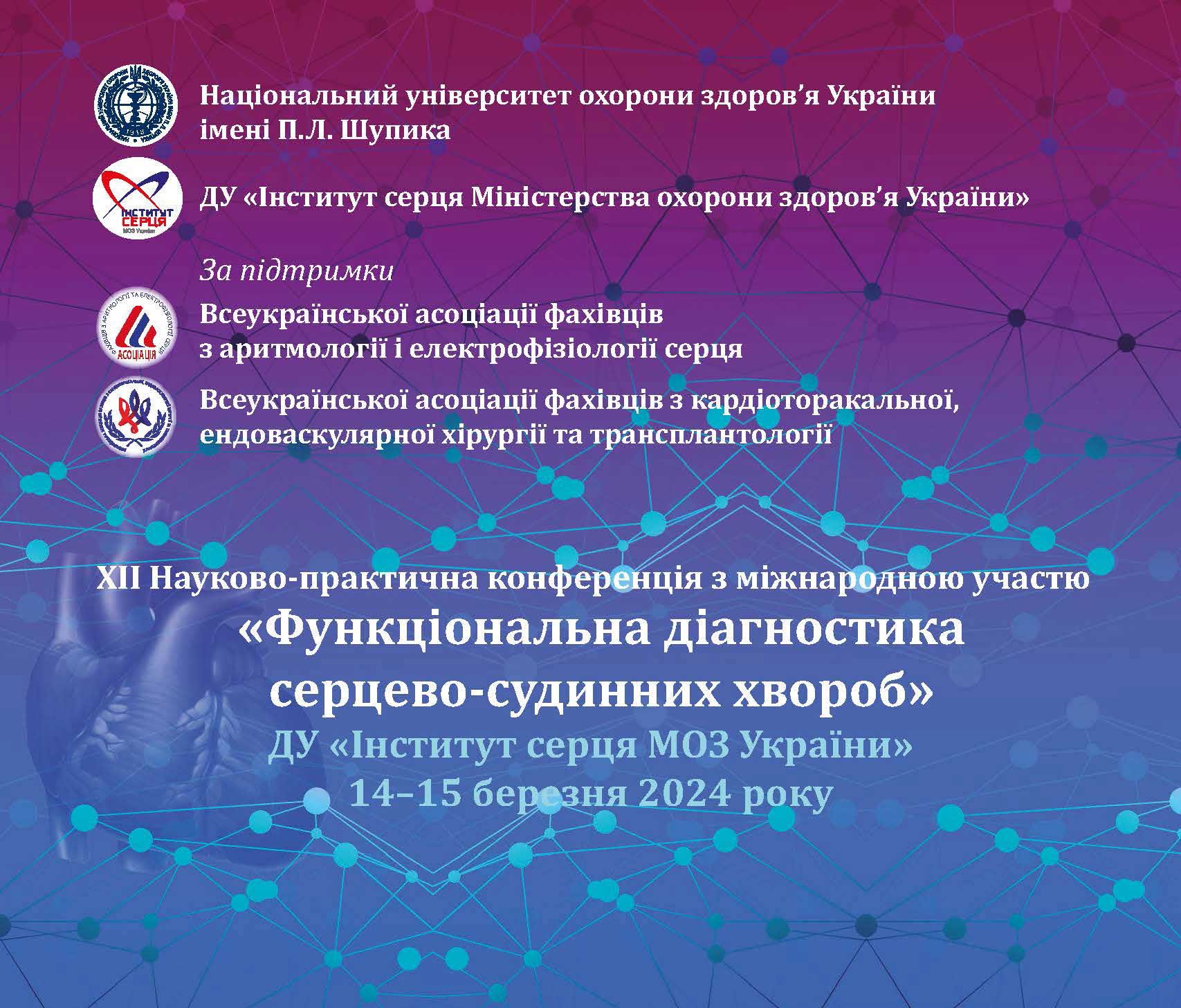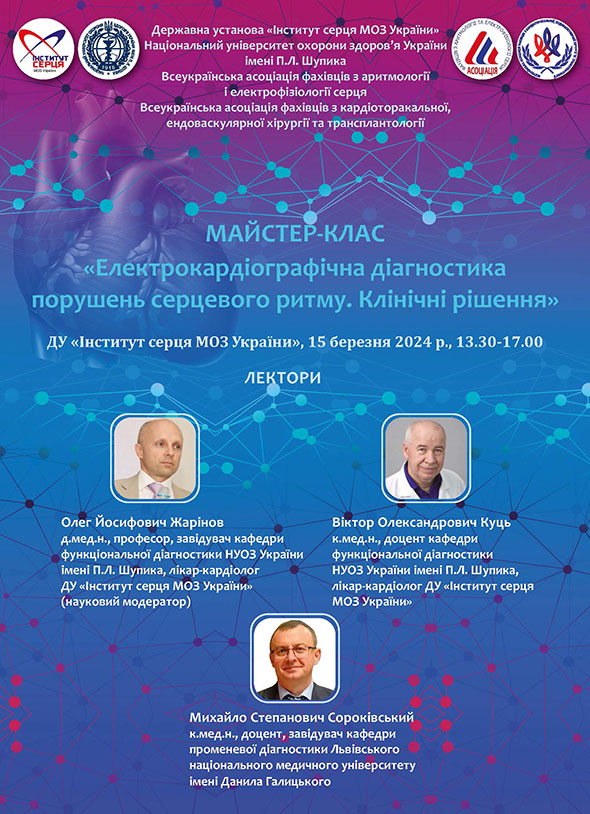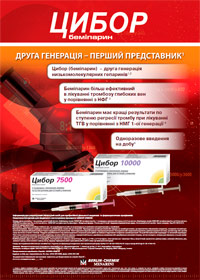Критерії вибору методу реваскуляризації міокарда в пацієнтів зі стабільною ішемічною хворобою серця у клінічній практиці
О.А. Єпанчінцева, О.Й. Жарінов, К.О. Міхалєв, А.В. Хохлов, Б.М. Тодуров
Література
1. The Task Force on Myocardial Revascularization of the European Society of Cardiology (ESC) and the European Association for Cardio-Thoracic Surgery (EACTS). 2014 ESC/EACTS Guidelines on myocardial revascularization. Eur Heart J. 2014;35:2541–2619.
2. Doherty J, Kort S, Mehran R. et al. ACC/AATS/AHA/ASE/ASNC/SCAI/SCCT/STS 2017 appropriate use criteria for coronary revascularization in patients with stable ischemic heart disease: a report of the American College of Cardiology Appropriate Use Criteria Task Force, American Association for Thoracic Surgery, American Heart Association, American Society of Echocardiography, American Society of Nuclear Cardiology, Society for Cardiovascular Angiography and Interventions, Society of Cardiovascular Computed Tomography, and Society of Thoracic Surgeons. J Nuc. Cardiol. 2017;24(5):1759–1792.
3. Abu Daya H, Hage F. Guidelines in review: ACC/AATS/AHA/ASE/ ASNC/SCAI/SCCT/STS 2017 appropriate use criteria for coronary revascularization in patients with stable ischemic heart disease. J Nucl Cardiol. 2017;24(5):1793–1799.
4. Fihn S, Gardin J, Abrams J. et al. 2012 ACCF/AHA/ACP/AATS/PCNA/SCAI/STS Guideline for the diagnosis and management of patients with stable ischemic heart disease: a report of the American College of Cardiology Foundation/American Heart Association Task Force on Practice Guidelines, and the American College of Physicians, American Association for Thoracic Surgery, Preventive Cardiovascular Nurses Association, Society for Cardiovascular Angiography and Interventions, and Society of Thoracic Surgeons. J Am Coll Cardiol. 2012;60(24):e44–e164.
5. Fihn S, Blankenship J, Alexander K. et al. 2014 ACC/AHA/AATS/PCNA/SCAI/STS focused update of the guideline for the diagnosis and management of patients with stable ischemic heart disease: a report of the American College of Cardiology/American Heart Association Task Force on Practice Guidelines, and the American Association for Thoracic Surgery, Preventive Cardiovascular Nurses Association, Society for Cardiovascular Angiography and Interventions, and Society of Thoracic Surgeons. J Am Coll Cardiol. 2014;64(18):1929–1949.
6. Kurlansky Р, Herbert M, Prince S, Mack M. Coronary bypass versus percutaneous intervention: sex matters. The impact of gender on long-term outcomes of coronary revascularization. Eur J Cardiothorac Surg. 2017;51(3):554–561.
7. Sanchez C, Dota A, Badhwar V. et al. Revascularization heart team recommendations as an adjunct to appropriate use criteria for coronary revascularization in patients with complex coronary artery disease. Catheter Cardiovasc Interv. 2016;88(4):E103–E112.
8. The Task Force on the management of stable coronary artery disease of the European Society of Cardiology. 2013 ESC guidelines on the management of stable coronary artery disease. Eur Heart J. 2013;34:2949–3003.
9. Pelegrino V, Dantas R, Clark A. Health-related quality of life determinants in outpatients with heart failure. Rev Latino-Am Enfermagem. 2011;19(3):451–457.
10. Hak T, Willems D, van der Wal G, Visser F. A qualitative validation of the Minnesota Living with Heart Failure Questionnaire. Qual Life Res. 2004;13(2):417–426.
11. Ware J, Sherbourne C. The MOS 36-item Short-Form Health Survey (SF-36): I. Conceptual framework and item selection. Med Care. 1992;30(6):473–483.
12. Nogueira I, Servantes D, Nogueira P. et al. Correlation between quality of life and functional capacity in cardiac failure. Arq Bras Cardiol. 2010;95(2):238–243.
13. KDIGO 2012 Clinical Practice Guideline for the evaluation and management of chronic kidney disease. Kidney Int Suppl. 2013;3(1):1–150.
14. The Task Force for the diagnosis and treatment of acute and chronic heart failure of the European Society of Cardiology (ESC). 2016 ESC Guidelines for the diagnosis and treatment of acute and chronic heart failure. Eur Heart J. 2016;18(8):891–975.
15. Mancini G, Farkouh M, Brooks M. et al. Medical Treatment and revascularization options in patients with type 2 diabetes and coronary disease. J Am Coll Cardiol. 2016;68(10):985–995.
16. Mancini G, Farkouh M, Verma S. Revascularization for patients with diabetes mellitus and stable ischemic heart disease: an update. Curr Opin Cardiol. 2017;32(5):608–616.
17. Giustino G, Dangas G. Surgical revascularization versus percutaneous coronary intervention and optimal medical therapy in diabetic patients with multi-vessel coronary artery disease. Prog Cardiovasc Dis. 2015;58(3):306–315.
18. Mavromatis K, Samady H, King S. et al. Revascularization in patients with diabetes: PCI or CABG or none. Curr Cardiol Rep. 2015;17(3):565.
19. Tu B, Rich B, Labos C, Brophy J. Coronary revascularization in diabetic patients a systematic review and bayesian network meta-analysis. Ann Intern Med. 2014;161(10):724–732.
20. Kulik A. Quality of life after coronary artery bypass graft surgery versus percutaneous coronary intervention: what do the trials tell us? Curr Opin Cardiol. 2017;32(6):707–714.
21. Takousi M, Schmeer S, Manaras I. et al. Health-Related quality of life after coronary revascularization: A systematic review with meta-analysis. Hellenic J Cardiol. 2016. pii: S1109-9666(16)30145-2.
22. Posenau J, Wojdyla D, Shaw L. et al. Revascularization strategies and outcomes in elderly patients with multivessel coronary disease. Ann Thorac Surg. 2017;104(1):107–115.
| [PDF] | [Зміст журналу] |
Феномен невідновленого кровотоку та фактори ризику його виникнення в пацієнтів з гострим інфарктом міокарда з елевацією сегмента ST після черезшкірного коронарного втручання
В.Й. Целуйко, М.М. Дьолог, О.А. Леоненко
Література
1. Iskhakov MM, Sayfullin RR, Yagafarov IR, Khatypov MG, Gazizov NV, Nugaybekova LA, Sayfutdinov RG. Primary percutaneous coronary interventions in patients with ST-segment elevation myocardial infarction complicated by «no-reflow» phenomenon. Kazan medical journal. 2015;96(3):325-329. (in Russ.).
2. Kovalenko VM, Kornatskyi VМ. Diseases of the circulatory system as a medical and social and socio-political problem. Кyiv, 2014. 280 p. (in Ukr.).
3. Araszkiewicz A, Grajek S, Lesiak M. et al. Effect of impaired myocardial reperfusion on left ventricular remodeling in patients with anterior wall acute myocardial infarction treated with primary coronary intervention. Am J Cardiol. 2006;98:725–728.
4. Brosh D, Assali AR, Mager A. et al. Effect of no-reflow during primary percutaneous coronary intervention for acute myocardial infarction on six-month mortality. Am J Cardiol. 2007;99:442–445.
5. Fajar JK, Mohammad ТH, Rohmand S. The predictors of no reflow phenomenon after percutaneous coronary intervention in patients with ST elevation myocardial infarction: A meta-analysis. Ind Heart J. 2018.
6. Giampaolo N, Rajesh K. Kharbanda. No-reflow: again prevention is better than treatment. Eur Heart J. 2010;31:2449–2455.
7. Harrison RW, Aggarwal A, Ou FS. et al. American College of Cardiology National Cardiovascular Data Registry. Incidence and outcomes of no-reflow phenomenon during percutaneous coronary intervention among patients with acute myocardial infarction. Am J Cardiol. 2013;111:178–184.
8. Henriques JP, Zijlstra F, Ottervanger JP. et al. Incidence and clinical significance of distal embolization during primary angioplasty for acute myocardial infarction. Eur Heart J. 2002;23:1112–1117.
9. Hoffmann R, Haager P, Arning J. et al. Usefulness of myocardial blush grade early and late after primary coronary angioplasty for acute myocardial infarction in predicting left ventricular function. Am J Cardiol. 2003;92:1015–1019.
10. Ito H, Okamura A, Iwakura K, Masuyama T. et al. Myocardial Perfusion Patterns Related to Thrombolysis in Myocardial Infarction Perfusion Grades After Coronary Angioplasty in Patients With Acute Anterior Wall Myocardial Infarction. Circulation. 1996;93:1993–1999.
11. Iwakura K, Ito H, Kawano S. et al. Predictive factors for development of the no-reflow phenomenon in patients with reperfused anterior wall acute myocardial infarction. J Am Coll Cardiol. 2001;38:472–477.
12. Jaffe R, Charron T, Puley G. et al. Microvascular obstruction and the no-reflow phenomenon after percutaneous coronary intervention. Circulation. 2008;117:3152–3156.
13. Novo G, Sutera MR, Lisi DD. et al. Assessment of No-Reflow Phenomenon by Myocardial Blush Grade and Pulsed Wave Tissue Doppler Imaging in Patients with Acute Coronary Syndrome. J Cardiovasc Echography. 2014;24 (2):52–56.
14. Limbruno U, De Carlo M, Pistolesi S. et al. Distal embolization during primary angioplasty: histopathologic features and predictability. Am Heart J. 2005;150:102–108.
15. Papapostolou S, Andrianopoulos N, Duffy SJ. et al. Long-term Clinical Outcomes of Transient and Persistent No-Reflow Following Percutaneous Coronary Intervention (PCI): A Multi-Center Australian Registry. EuroIntervention. 2017. 3.
16. Resnic FS, Wainstein M. No-reflow is an independent predictor of death and myocardial infarction after percutaneous coronary intervention. Am Heart J. 2013;145 (1):42–46.
17. Turschner O, D’hooge J, Dommke C. et al. The sequential changes in myocardial thickness and thickening which occur during acute transmural infarction, infarct reperfusion and the resultant expression of reperfusion injury. Eur Heart J. 2004;25:794–803.
18. Uyarel H, Cam N, Okmen E. et al. Level of Selvester QRS score is predictive of ST-segment resolution and 30-day outcomes in patients with acute myocardial infarction undergoing primary coronary intervention. Am Heart J. 2016;151:1239–1247.
19. Van‘t Hof AW, Liem A, Suryapranata H. et al. On behalf of the Zwolle Myocardial Infarction Study Group: Angiographic assessment of myocardial reperfusion in patients treated with primary angioplasty for acute myocardial infarction. Myocardial Blush Grade. Circulation. 1998;97:2302–2306.
20. Yip HK, Chen MC, Chang HW. et al. Angiographic morphologic features of infarct-related arteries and timely reperfusion in acute myocardial infarction: predictors of slow-flow and no-reflow phenomenon. Chest. 2002;122:1322–1332.
| [PDF] | [Зміст журналу] |
Аналіз анатомо-фізіологічних особливостей правих відділів серця, що впливають на ефективність балонної вальвулопластики та підвищують ризик проведення повторних втручань, у дітей зі стенозом клапана легеневої артерії
А.В. Максименко, Ю.Л. Кузьменко, А.А. Довгалюк, М.П. Радченко, О.О. Мотречко
Література
1. Behjati-Ardakani M, Forouzannia SK, Abdollahi MH, Sarebanhassanabadi M. Immediate, short, intermediate and long-term results of balloon valvuloplasty in congenital pulmonary valve stenosis. Med Iran. 2013;51(5):324–328.
2. Holzer RJ, Gauvreau K, Kreutzer J. et al. Safety and efficacy of balloon pulmonary valvuloplasty: a multicenter experience. Catheter Cardiovasc Interv. 2012;80(4):663–672.
3. Kan JS, White RIJr, Mitchell SE, Gardner TJ. Percutaneous balloon valvuloplasty: a new method for treating congenital pulmonary-valve stenosis. New Engl J Med. 1982;307:540–542.
4. Liu TL, Gao W. Pulmonary valve stenosis. Cardiac Catheterization for Congenital Heart Disease. Ed. G. Butera. 1st ed. New York, Dordrecht, London: Springer, Milan Heidelberg, 2015:261–277.
5. Rubio-Alvarez V, Limon RL, Soni J. Valvulotomias intracardiacas por medio de un cateter. Arch Inst Cardio Mexico. 1953;23:183–192.
6. Sehar T, Qureshi AU, Kazmi U. et al. Balloon valvuloplasty in dysplastic pulmonary valve stenosis: immediate and intermediate outcomes. Coll Physicians Surg Pak. 2015;25(1):16–21.
7. Semb BKJ, Tjonneland S, Stake G, Aabyholm G. Balloon valvulotomy’of congenital pulmonary valve stenosis with tricuspid valve insufficiency. Cardiovasc Radiol. 1979;2:239–241.
8. Shi-min Yuan PHD. Supravalvular pulmonaty stenosis: congenital versus asquired. Acta Medica Mediterranea. 2017;33:849.
9. Wang Qing, Wu Yu Rong, Zhang Li Na et al. Evaluating the risk factors of reintervention of neonates with PA/IVS and CPS/IVS after PBPV as initial intervention method. J Cardiology. 2016;68:190–195.
| [PDF] | [Зміст журналу] |
Особливості клапанозбережного втручання при злоякісній пухлині правого шлуночка серця
Р.М. Вітовський, В.В. Ісаєнко, О.А. Піщурін, В.Ф. Онищенко, І.В. Мартищенко, Д.М. Дядюн, В.В. Грабарчук
Література
1. Knyshov GV, Vitovskiy RM, Zakharova VP. Tumors of the heart. Кyiv, 2005. 256 p. (in Russ.).
2. Barnes H, Conaglen P, Russell P. et al. Clinicopathological and surgical experience with primary cardiac tumors. Asian Cardiovasc Thorac Ann. 2014;22:1054–1058.
3. Barreiro M, Renilla A, Jimenez JM. et al. Primary cardiac tumors: 32 years of experience from a Spanish tertiary surgical center. Cardiovasc Pathol. 2013;22:424–427.
4. Bruce CJ. Cardiac tumours: diagnosis and management. Heart. 2011;97(2):151–160.
5. Burazor I, Aviel-Ronen S, Imazio M. et al. Primary malignancies of the heart and pericardium. Clin Cardiol. 2014;37:582–588.
6. Cresti A, Chiavarelli M, Glauber M. et al. Incidence rate of primary cardiac tumors: a 14-year population study. J Cardiovasc Med. (Hagerstown). 2016;17:37–43.
7. Dias RR, Fernandes F, Ramires FJ. et al. Mortality and embolic potential of cardiac tumors. Arq Bras Cardiol. 2014;103:13–18.
8. Habertheuer A, Laufer G, Wiedemann D. et al. Primary cardiac tumors on the verge of oblivion: a European experience over 15 years. J Cardiothorac Surg. 2015;10:56.
9. Isogai T, Yasunaga H, Matsui H. et al. Factors affecting in-hospital mortality and likelihood of undergoing surgical resection in patients with primary cardiac tumors. J Cardiol. 2016;10:1016.
10. Padalino MA, Vida VL, Boccuzzo G. et al. Surgery for primary cardiac tumors in children: early and late results in a multicenter European Congenital Heart Surgeons Association study. Circulation. 2012;126:22–30.
| [PDF] | [Зміст журналу] |
Випадок кавернозної гемангіоми з вогнищевою проліферацією ендотелію лівого передсердя
М.В. Войцехівська, І.В. Іркін, Г.Г. Прус, О.С. Чумак, В.О. Куць, М.В. Шиманко, Г.І. Дарвіш, О.Й. Жарінов
Література
1. Vitovskiy RM, Beshliaha VM. Features of diagnostics and surgical treatment of primary cardiac tumors. Medycni initsiatyvy. 2014;3(5). (in Ukr.).
2. Abad C, de Varona S, Limeres MA. et al. Resection of a left atrial hemangioma: report of a case and overview of the literature on resected cardiac hemangiomas. Tex Heart Inst. J. 2008;35:69–72.
3. Esmaeilzadeh M, Jalalian R, Maleki M. et al. Cardiac cavernous hemangioma. Eur J Echocardiography. 2007;8(6):487–489.
4. Han Y, Chen X, Wang X. et al. Cardiac capillary hemangioma: a case report and brief review of the literature. J Clin Ultrasound. 2014;42:53–56.
5. McAllister HA, Fenoglio JJ Jr, Firminger HI. Tumors of the cardiovascular system 2nd series. Atlas of tumor pathology. Washington DCArmed Forces Institute of Pathology, 1978:46–51.
6. Rizzoli G, Bot-tio T, Pittarello D. et al. Atrial septal mass: transesophageal echocardiographic assessment. J Thorac Cardiovasc Surg. 2004;128:767–769.
| [PDF] | [Зміст журналу] |
Огляд рекомендацій Американського товариства кардіологів / Американської асоціації серця / Товариства серцевого ритму 2017 року щодо ведення пацієнтів із синкопальними станами
М.Т. Ватутін, Є.В. Склянна, І.А. Сологуб, М.М. Бондаренко
Література
1. Shen W-K, Sheldon RS, Benditt DG. et al. 2017 ACC/AHA/HRS guideline for the evaluation and management of patients with syncope: Executive Summary. Circulation. 2017;136:e25–59.
| [PDF] | [Зміст журналу] |












